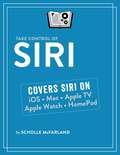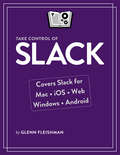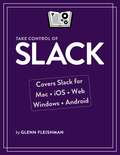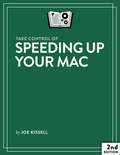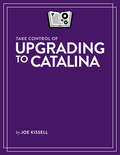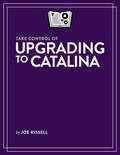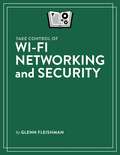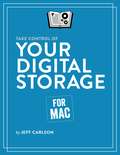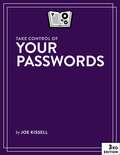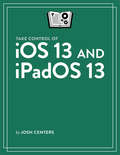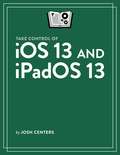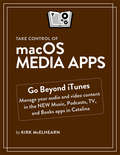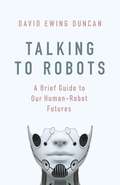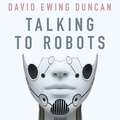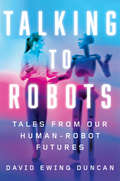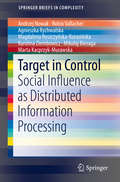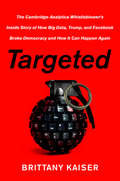- Table View
- List View
Take Control of Siri
by Scholle McFarlandWhen it comes to using your Apple devices, Siri is increasingly the hands-free, time-saving, and fun technology that ties everything together. Whether you want to ask a question, make a call, find your iPhone, or set a timer—not only can Siri do it, but it usually offers the fastest way. This book explores how to get the most out of Siri on your iPhone, iPad, Apple Watch, Mac, and HomePod.
Take Control of Slack
by Glenn FleishmanMaster Slack for work and fun!The Slack group messaging system has become an integral part of work life (and even social life) for millions of people. It's a feature of the modern business landscape, but how can you make the best use of this powerful, 21st-century tool to both get your job done and have fun? In this book, Glenn Fleishman addresses every major type of Slack user:New user: If you're interested in or tempted by Slack but have never used it, this book will help you get up to speed quickly.Experienced user: If you use Slack already and want to get more out of it, this book will guide you to more efficient and more sophisticated use and control.Reluctant user: If Slack is a requirement for your workplace, nonprofit group, or other organization, this book will help you overcome frustration and confusion.Slack can make your work life better. This book helps you master Slack! It shows you things you'll never learn by reading the online documentation or simply poking around, based on Glenn's years of experience in multiple Slack teams.Among the many questions this book answers are:How do I get started using Slack, including creating my first workspace?How can I manage the number (and manner) of notifications I get on my desktop and on my mobile devices?Is there any way to edit the message I just posted so I can fix a mistake?How do I find other channels in my Slack workspace--or make new ones?How do I make audio or video calls in Slack, or use screen sharing?What are the differences between direct messages and public messages in Slack?How much privacy can I expect in Slack from coworkers, bosses, owners, and Slack itself?How much can I do in Slack for free? What features make sense to pay for?How do people find and enter emoji in messages?What does it mean when names in the sidebar are bold or italic?What do the numbers next to channel or conversation names indicate?What exactly is Slackbot, and why is it talking to me?How do I perform advanced searches to find what I need?How do I find and install Slack apps?Take Control of Slack replaces two previous titles: Take Control of Slack Basics and Take Control of Slack Admin. Although this new book borrows some elements from its predecessors, it's a brand-new, completely rethought guide that's up to date with the latest versions of Slack (right down to its brand-new icon!).
Take Control of Slack
by Glenn FleishmanWrap your head around how Slack group messaging works, learn to communicate and collaborate using its many features, and discover how to use integrations and notifications to get more out of it. The book explains finding channels, starting conversations, posting messages, interacting with bots, and more! The Slack web app is covered, along with apps for macOS, Windows, iOS, and Android.
Take Control of Speeding Up Your Mac
by Joe KissellDon’t settle for a sluggish Mac! If it seems your Mac has become slower and less responsive over time, it’s not your imagination—but it’s also a problem you can solve without buying a new computer. This comprehensive book teaches you how to find the exact causes of slow performance and take steps to make your Mac zippy again.
Take Control of Troubleshooting Your Mac
by Joe KissellThis essential guide teaches you 17 basic troubleshooting procedures and how to solve 21 common problems, along with an easy-to-follow way to troubleshoot novel problems. Whether your Mac fails to boot, loses its Internet connection, or won't cooperate, this book has the advice you need to find a solution.
Take Control of Upgrading to Catalina
by Joe KissellMake a painless move to macOS 10.15!macOS 10.15 Catalina makes your Mac more powerful, safer, and easier to use. But upgrading from an older version of macOS can sometimes be a confusing and frustrating experience--especially if you're currently running a much older operating system, or if you encounter unexpected hiccups in the process. And this time, there are a few more gotchas than usual--including the elimination of support for 32-bit apps and certain other types of third-party software, additional changes to the disk structure that may affect your backups, and an unexpectedly large number of security alerts. But forewarned is forearmed, and this book guides you through everything you need to know to successfully upgrade your Mac to Catalina.In Take Control of Upgrading to Catalina, Mac expert Joe Kissell outlines a process that will take the stress out of upgrading, showing you how to make the switch more efficiently and in the way that's right for you. Learn what you need to know before you begin, how to prepare your Mac and make backups, and be ready to make decisions about questions that arise during and after installation.The book explains in detail how to…Start fast: A Quick Start overview helps you read lightly or more deeply, depending on your needs.Take in the view: Find out what you can look forward to in Catalina.Check for compatibility: Make sure your hardware and software are ready for Catalina.Back up: Avoid upgrade anxiety by ensuring you can return to the previous state of your Mac--and that you can boot from your backup.Pick a plan: Go for an easy in-place upgrade or consider a more complex clean install. Find out which option is right for you.Install: Download and store the installer where it won't be deleted, with special tips for people who want to install on multiple Macs or who have bandwidth limitations. And, although running the installer will be easy for many people, you'll find full steps for what to click and when.Deal with all those dialogs: Your Mac will probably ask you a long list of questions during and after the upgrade. Learn the best ways to answer them.Do a post-installation tune-up: Make sure your new system is running smoothly by completing important housekeeping tasks and making a few key decisions. Troubleshoot: Yikes! It is possible that something will go wrong during installation, or that once you've booted up under Catalina that you'll encounter a serious problem. Joe's time-tested troubleshooting advice will help get your system working again.In addition, this book covers topics such as:How Catalina affects your bootable duplicatesChanges to Setup Assistant, what the new screens mean, and how to handle themWhat's new, added, removed, and rearranged in System PreferencesWhat to do if you run the Catalina installer, restart, and find your Mac is still running your old version of macOSRevised instructions for downgrading to your earlier system if that becomes necessary
Take Control of Upgrading to Catalina
by Joe KissellManage your upgrade to Catalina with ease using Joe Kissell's expert advice in "Take Control of Upgrading to Catalina." Learn what you need to know before you begin, how to prepare your Mac, and be ready to make decisions about installation questions. Find out how to resolve common upgrading problems, and what has changed in macOS since the last version.
Take Control of Wi-Fi Networking and Security
by Glenn FleishmanSetting up and securing a Wi-Fi network can be complicated and confusing. This book helps you over every hurdle involved in picking gateways, setting up a network, adding devices, and securing the network and connected phones, tablets, and computers. It’s useful for those who have set up networks in the past and want to replace them with new gear, as well as people who have never built a Wi-Fi network before.
Take Control of Your Apple ID
by Glenn FleishmanThis book covers everything someone needs to know about configuring an Apple ID account, interactions with iCloud-based services, and troubleshooting account access.
Take Control of Your Browser
by Robyn WeismanYour web browser is the gateway to a vast array of information and apps. This book helps you master this essential app, finding the best browser for your needs and configuring it to work just the way you want.
Take Control of Your Digital Photos
by Jeff CarlsonThis book gives photographers using Mac or Windows computers the information they need to build and maintain a digital photo workflow that makes it easy to import, rate, tag, and store photos to find them quickly and easily later. It helps you spend more time on the enjoyable aspects of photography—shooting and viewing your photos—and less on the mundane but essential task of managing all your photos.
Take Control of Your Digital Storage
by Jeff CarlsonThis book demystifies storage on the Mac, from mechanical hard drives to solid-state disks, and covering topics such as network-attached storage (NAS), cloud storage, repairing and managing disks, encryption, filesystems (including APFS), and managing data.
Take Control of Your Online Privacy
by Joe KissellLearn what's private online (not much)--and what to do about it!Nowadays, it can be difficult to complete ordinary activities without placing your personal data online, but having your data online puts you at risk for theft, embarrassment, and all manner of trouble. In this book, Joe Kissell helps you to develop a sensible online privacy strategy, customized for your needs. Whether you have a Mac or PC, iOS or Android device, set-top box, or some other network-enabled gadget, you'll find practical advice that ordinary people need to handle common privacy needs (secret agents should look elsewhere). You'll learn how to enhance the privacy of your internet connection, web browsing, email messages, online chatting, social media interactions, and file sharing, as well as your mobile phone or tablet, and Internet of Things devices like webcams and thermostats. Parents will find important reminders about protecting a child's privacy. The book also includes Joe's carefully researched VPN recommendations.The book is packed with sidebars that help you get a handle on current topics in online privacy, including international travel, quantum computing, why you should beware of VPN reviews online, two-factor authentication, privacy and your ISP, understanding how ads can track you, and more.You'll receive savvy advice about topics such as these:Why worry? Learn who wants your private data, and why they want it. Even if you don't believe you have anything to hide, you almost certainly do, in the right context. Would you give just anyone your financial records or medical history? Didn't think so.Manage your Internet connection: Understand privacy risks, prevent snoops by securing your Wi-Fi network, and take key precautions to keep your data from leaking out. Also find advice on using a VPN, plus why you should never believe a VPN review that you read on the Internet--even if it seems like it was written by Joe!Browse and search the web: Learn what is revealed about you when you use the web. Avoid bogus websites, connect securely where possible, control your cookies and history, block ads, browse and search anonymously, and find out who is tracking you. Also, take steps to protect passwords and credit card data.Send and receive email: Find out how your email could be intercepted, consider when you want email to be extra private (such as when communicating with a lawyer), find out why Joe doesn't recommend email encryption as a solution to ordinary privacy needs (but find pointers for how to get started if you want to try it--or just encrypt an attachment, which is easier), get tips for sending email anonymously, and read ideas for alternatives to email.Talk and chat online: Consider to what extent any phone call, text message, or online chat is private, and find tips for enhancing privacy when using these channels.Watch your social media sharing: Understand the risks and benefits of sharing personal information online (especially on Facebook!), tweak your settings, and consider common-sense precautions.Share files: What if you want to share (or collaborate on) a contract, form, or other document that contains confidential information? Find out about the best ways to share files via file server, email attachment, cloud-based file sharing service, peer-to-peer file sharing, or private cloud.Check your electronics: All sorts of gizmos can connect to the Internet these days, so everything from a nannycam to smart light bulbs should be considered in your online privacy strategy.Think mobile: Ponder topics like SIM card encryption keys, supercookies, location reporting, photo storage, and more as you decide how to handle privacy for a mobile phone or tablet.
Take Control of Your Online Privacy
by Joe KissellNowadays, it can be difficult to complete ordinary activities without placing your personal data online, but having your data online puts you at risk for theft, embarrassment, and all manner of trouble. Read this book to find practical advice that ordinary people need to handle common online privacy problems and to develop a sensible online privacy strategy, customized for your needs.
Take Control of Your Passwords
by Joe KissellPassword overload has driven many of us to take dangerous shortcuts. If you think ZombieCat12 is a secure password, that you can safely reuse a password, or that no one would try to steal your password, think again! Overcome password frustration with expert advice from Joe Kissell!
Take Control of iOS 13 and iPadOS 13
by Josh CentersLearn how to make the most of Apple's mobile operating systems!The latest annual update to iOS features the usual selection of new features, improved user interface, and security enhancements. It also marks the split of Apple's mobile operating system into iOS (for iPhone and iPod touch) and iPadOS (for iPad only). This is more than just a name change; with iPadOS 13, the iPad gets huge improvements that bring it much closer to the computing power and flexibility we expect from conventional computers. TidBITS Managing Editor Josh Centers is back to guide you through all the major capabilities of both operating systems in this new book.Take Control of iOS 13 and iPadOS 13 goes far beyond the new features, providing an extensive guide to getting the most out of iOS 13 and iPadOS 13. Among other things, you'll learn how to:New! Discover all the major changes in iOS and iPadOSNew! Use activity views (which replace Share sheets and are for more than just sharing)New! Enable Dark Mode on your mobile deviceUpdated! Use the new Find My appNew! Make the most of improved text editing toolsUpdated! Use Siri and Shortcuts to do even more than before, thanks to significantly expanded capabilitiesNew! Use accessibility improvements, including voice control and mouse supportUpdated! Discover the new (and existing) capabilities of Apple's upgraded apps--including Files, Mail, Maps, Messages, Notes, and RemindersUpdated! Use Screen Time to make better choices about when and how you use your deviceNew! Work with the updated iPad Home screen, Dock, and onscreen keyboardNew! Learn about the new iPad multitasking capabilities, including more ways to split the screen, use multiple windows, and drag & drop between appsNew! Browse the web with ease using the desktop-class Safari for iPadOSNew! Use the significantly updated Camera and Photos apps to take photos and videos, apply camera effects, and organize your mediaMake sense of the Lock screen, Home screen, and Control Center--and customize them to meet your needsSearch with SpotlightSwitch between apps and use Handoff to transfer your work Navigate the App StoreUnderstand the ins and outs of Family SharingManage your data--both locally on your device and in the cloudMake calls and use FaceTime and VoicemailOrganize your Wallet and use Apple PayProtect your privacyImprove your battery life…and much more!Anyone with a compatible iPhone, iPad, or iPod touch will benefit from Josh's in-depth explanations.
Take Control of iOS 13 and iPadOS 13
by Josh CentersWhether you use an iPad, iPhone, or iPod touch, you'll find lots to explore in "Take Control of iOS 13 and iPadOS 13" by TidBITS Managing Editor Josh Centers. Learn about what's new in iOS 13 and iPadOS 13—and how to customize them to fit your needs.
Take Control of macOS Media Apps
by Kirk McElhearnGo beyond iTunes with Catalina's new media appsIn macOS 10.15 Catalina, Apple did away with iTunes. In its place are three new apps--Music, TV, and Podcasts--with audiobooks now handled by the Books app and syncing of mobile devices handled by the Finder. The new apps also add more features (while, sadly, removing a few things too). Take Control of macOS Media Apps is your guide to this new, post-iTunes world. Kirk McElhearn, author of earlier books on iTunes 10, 11, and 12, is back with a new book that shows you how to manage your music, videos, podcasts, and audiobooks in Catalina.The book covers how to:Play Music: Learn the basics of playing audio (and even music videos) in the Music app. You'll also find tips on making quick playlists with Genius and Up Next, learn the best ways to search for the music you want to hear, stream music to other devices in your home, and view lyrics while tunes play.Stream Music: Use Apple Music, a paid music subscription service, to listen to any of 50 million tracks. Or listen to live broadcasts from Apple Music Radio (including Beats 1).View Your Music and Other Content: Learn how to use the sidebar, view your music library, and work with contextual menus in the Music app.Store Your Music Library in the Cloud: What are the pros and cons of Apple's Cloud Music Library? How do Music and iTunes Match figure out whether to upload your music when setting up your Cloud Music Library? You'll get answers to these questions and more.Use the iTunes Store: Find tips on shopping in the iTunes Store, and get advice on sharing your purchases with family members and among your various Apple devices.Tag Your Music: Tags are bits of information that can describe your media. Learn which tags to bother changing, the best ways to add lyrics and album art, how to rate songs with stars, loves, or both, and more.Organize Your Music: Make a simple playlist of romantic songs, workout songs, or whatever theme you like. You'll learn how to create smart playlists that, for example, comprise only your 5-star faves or only tunes you haven't heard recently, and how to transfer playlists to the Apple Watch. You'll also find help with operational issues like eliminating duplicates from your music library.Manage and Share Media Files: Whether you want to casually share a playlist from your laptop when visiting a friend or you want to make all your media available on all your home's computers, you'll find out how Media Sharing and Home Sharing make sharing possible. You'll also learn how to manage massive media libraries and store media files on external drives.Listen to Audiobooks: Discover how to download and play audiobooks in the Books app, and how to manage your audiobook library.View Movies and TV Shows: Use the TV app to watch videos, including those purchased or rented from the iTunes Store and those you add yourself.Listen to and Watch Podcasts: Sample and subscribe to podcasts, pick a method of syncing podcast episodes to your iPhone or iPad, and learn about creating your own podcast station.Sync Media: You've put all your media on your Mac…now, how do you transfer it to a mobile Apple device such as an iPhone, an iPad, an old-school iPod, or an Apple Watch? And how do you use an Apple TV to enjoy the media on your Mac?Rip, Burn, and Print: Add content to your media apps with Kirk's detailed steps for "ripping" music CDs and audiobooks. Also learn how to burn music from Music onto a CD, and get directions for printing a song list.Extend with AppleScript: Learn how to make the Music and TV apps do more with AppleScript.
Talk Radio’s America: How an Industry Took Over a Political Party That Took Over the United States
by Brian RosenwaldThe march to the Trump presidency began in 1988, when Rush Limbaugh went national. Brian Rosenwald charts the transformation of AM radio entertainers into political kingmakers. By giving voice to the conservative base, they reshaped the Republican Party and fostered demand for a president who sounded as combative and hyperbolic as a talk show host.
Talking to Robots: A Brief Guide to Our Human-Robot Futures
by David Ewing DuncanOne of Time magazine's '32 Books You Need to Read This Summer' -- 'a riveting read'.'Intensely readable, downright terrifying, and surprisingly uplifting.'Vanity Fair'A fascinating work of imaginative futurology, a science journalist takes a look at our current technologies and anticipates the human-robot future that could await us - one full of warrior bots, politician bots, doctor bots and sex bots.'One of Barbara VanDenburgh's '5 Books Not to Miss', USA TodayOne of the best summer reads of 2019, according to top authors David Baldacci and Elizabeth Acevedo on USA Today's Today programme. 'A refreshing variation on the will-intelligent-robots-bring-Armageddon genre . . . this colorful mixture of expert futurology and quirky speculation does not disappoint' Kirkus ReviewsWhat robot and AI systems are being built and imagined right now? What do they say about us, their creators? Will they usher in a fantastic new future, or destroy us? What do some of our greatest thinkers, from physicist Brian Greene and futurist Kevin Kelly to inventor Dean Kamen, geneticist George Church and filmmaker Tiffany Shlain, anticipate for our human-robot future? For even as robots and AI intrigue us and make us anxious about the future, our fascination with robots has always been about more than the potential of the technology - it also concerns what robots tell us about being human.From present-day Facebook and Amazon bots to near-future 'intimacy' bots and 'the robot that swiped my job' bots, bestselling American popular science writer David Ewing Duncan's Talking to Robots is a wonderfully entertaining and insightful guide to possible future scenarios about robots, both real and imagined.Featured bots include robot drivers; doc bots; politician bots; warrior bots; sex bots; syntheticbio bots; dystopic bots that are hopefully just bad dreams; and ultimately, God Bot (asdescribed by physicist Brian Greene). These scenarios are informed by discussions with well-known thinkers, engineers, scientists, artists, philosophers and others, who share with us their ideas, hopes and fears about robots. David spoke with, among others, Kevin Kelly, David Baldacci, Brian Greene, Dean Kamen, Craig Venter, Stephanie Mehta, David Eagleman, George Poste, George Church, General R. H. Latiff, Robert Seigel, Emily Morse, David Sinclair, Ken Goldberg, Sunny Bates, Adam Gazzaley, Tim O'Reilly, Tiffany Shlain, Eric Topol and Juan Enriquez.These discussions, along with some reporting on bot-tech, bot-history and real-time societal andethical issues with robots, are the launch pads for unfurling possible bot futures that are informed by how people and societies have handled new technologies in the past.The book describes how robots work, but its primary focus is on what our fixation with botsand AI says about us as humans: about our hopes and anxieties; our myths, stories, beliefs andideas about beings both real and artificial; and our attempts to attain perfection.We are at a pivotal moment when our ancient infatuation with human-like beings with certainattributes or superpowers - in mythology, religion and storytelling - is coinciding with ourability to actually build some of these entities.
Talking to Robots: A Brief Guide to Our Human-Robot Futures
by David Ewing DuncanOne of Time magazine's '32 Books You Need to Read This Summer' -- 'a riveting read'.'Intensely readable, downright terrifying, and surprisingly uplifting.'Vanity Fair 'A fascinating work of imaginative futurology, a science journalist takes a look at our current technologies and anticipates the human-robot future that could await us - one full of warrior bots, politician bots, doctor bots and sex bots.'One of Barbara VanDenburgh's '5 Books Not to Miss', USA Today One of the best summer reads of 2019, according to top authors David Baldacci and Elizabeth Acevedo on USA Today's Today programme. 'A refreshing variation on the will-intelligent-robots-bring-Armageddon genre . . . this colorful mixture of expert futurology and quirky speculation does not disappoint' Kirkus ReviewsWhat robot and AI systems are being built and imagined right now? What do they say about us, their creators? Will they usher in a fantastic new future, or destroy us? What do some of our greatest thinkers, from physicist Brian Greene and futurist Kevin Kelly to inventor Dean Kamen, geneticist George Church and filmmaker Tiffany Shlain, anticipate for our human-robot future? For even as robots and AI intrigue us and make us anxious about the future, our fascination with robots has always been about more than the potential of the technology - it also concerns what robots tell us about being human.From present-day Facebook and Amazon bots to near-future 'intimacy' bots and 'the robot that swiped my job' bots, bestselling American popular science writer David Ewing Duncan's Talking to Robots is a wonderfully entertaining and insightful guide to possible future scenarios about robots, both real and imagined.Featured bots include robot drivers; doc bots; politician bots; warrior bots; sex bots; syntheticbio bots; dystopic bots that are hopefully just bad dreams; and ultimately, God Bot (asdescribed by physicist Brian Greene). These scenarios are informed by discussions with well-known thinkers, engineers, scientists, artists, philosophers and others, who share with us their ideas, hopes and fears about robots. David spoke with, among others, Kevin Kelly, David Baldacci, Brian Greene, Dean Kamen, Craig Venter, Stephanie Mehta, David Eagleman, George Poste, George Church, General R. H. Latiff, Robert Seigel, Emily Morse, David Sinclair, Ken Goldberg, Sunny Bates, Adam Gazzaley, Tim O'Reilly, Tiffany Shlain, Eric Topol and Juan Enriquez.These discussions, along with some reporting on bot-tech, bot-history and real-time societal andethical issues with robots, are the launch pads for unfurling possible bot futures that are informed by how people and societies have handled new technologies in the past.The book describes how robots work, but its primary focus is on what our fixation with botsand AI says about us as humans: about our hopes and anxieties; our myths, stories, beliefs andideas about beings both real and artificial; and our attempts to attain perfection.We are at a pivotal moment when our ancient infatuation with human-like beings with certainattributes or superpowers - in mythology, religion and storytelling - is coinciding with ourability to actually build some of these entities.
Talking to Robots: Tales from Our Human-Robot Futures
by David Ewing DuncanAward-winning journalist David Ewing Duncan considers 24 visions of possible human-robot futures—Incredible scenarios from Teddy Bots to Warrior Bots, and Politician Bots to Sex Bots—Grounded in real technologies and possibilities and inspired by our imagination. What robot and AI systems are being built and imagined right now? What do they say about us, their creators? Will they usher in a fantastic new future, or destroy us? What do some of our greatest thinkers, from physicist Brian Greene and futurist Kevin Kelly to inventor Dean Kamen, geneticist George Church, and filmmaker Tiffany Shlain, anticipate about our human-robot future? For even as robots and A.I. intrigue us and make us anxious about the future, our fascination with robots has always been about more than the potential of the technology–it’s also about what robots tell us about being human.
Target in Control: Social Influence as Distributed Information Processing (SpringerBriefs in Complexity)
by Robin R. Vallacher Agnieszka Rychwalska Magdalena Roszczyńska-Kurasińska Karolina Ziembowicz Marta Kacprzyk-Murawska Andrzej K. Nowak Mikolaj BiesagaThis concise monograph introduces and examines social influence from the perspective of the so-called target, rather than from the source, thus providing for the first time a bidirectional account of this pervasive social phenomenon, further bridging simple micro-level dyadic interaction rules with macro-level properties of the (social) system. This integrative approach allows for advanced models of influence to be developed in both the social and natural sciences (e.g. social animals). In particular, when used to investigate emergent properties of social change, this approach shows that social transitions occur as “bubbles of new” in the “sea of old.” While in the traditional view influence is synonymous with achieving power and control over others, the present approach to social influence puts the emphasis on the target’s motives and strategies. Here, the target may actively seek out influence to help forge opinions and achieve guidance regarding courses of action. In this process, the target observes others, models their thought and behavior, and asks for information and opinions. In this broadened perspective, the processes of social influence enables those being influenced (the targets) to use the knowledge and processing capacity of influence sources to maximize their access to information, minimize their processing effort, while optimizing their own functioning and that of the social system in which they evolve. This short text addresses above all scientists interested in social influence in the fields of psychology, sociology, economy, marketing, and biology. However, also researchers interested in modeling social processes, especially opinion dynamics and social change, such as computer scientists, physicists and applied mathematicians will benefit from the insights provided.
Targeted: The Cambridge Analytica Whistleblower's Inside Story of How Big Data, Trump, and Facebook Broke Democracy and How It Can Happen Again
by Brittany KaiserAn “important and gripping” memoir by the woman who blew the whistle on Cambridge Analytica and the data industry’s unethical practices (The Washington Post).When Brittany Kaiser joined Cambridge Analytica—the UK-based political consulting firm funded by conservative billionaire and Donald Trump patron Robert Mercer—she was an idealistic young professional, a veteran of Barack Obama’s 2008 campaign with degrees in human rights law and international relations. Her goal was to utilize data for humanitarian purposes, most notably to prevent genocide and human rights abuses. But her experience inside Cambridge Analytica opened her eyes to the tremendous risks this unregulated industry poses to privacy and democracy. In this explosive memoir, she reveals the disturbing truth about the multi-billion-dollar data industry, revealing how companies are getting richer using our personal information and exposing how Cambridge Analytica exploited weaknesses in privacy laws to help elect Donald Trump in 2016.Targeted is Kaiser’s eyewitness chronicle of the dramatic and disturbing story of the rise and fall of Cambridge Analytica. She reveals how Facebook’s lax policies and lack of sufficient national laws allowed voters to be manipulated in both Britain and the US, where personal data was weaponized to spread fake news and racist messaging during the Brexit vote and the 2016 election. In the aftermath, as she became aware of the horrifying reality of what Cambridge Analytica had done, Kaiser made the difficult choice to expose the truth. Risking her career, relationships, and personal safety, she told authorities about the industry’s unethical practices, eventually testifying before Parliament about the company’s Brexit efforts and helping Special Counsel Robert Mueller’s investigation into Russian interference in the 2016 election, alongside at least ten other international investigations.Packed with never-before-publicly-told stories, Targeted goes inside the secretive meetings with Trump campaign personnel—and makes the case that legal oversight of the data industry is not only justifiable but essential to ensuring the long-term safety of our democracy.“Captivating and revelatory.” —Publishers Weekly (starred review)Includes photographs
